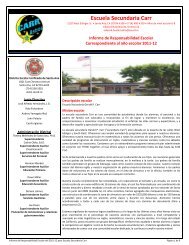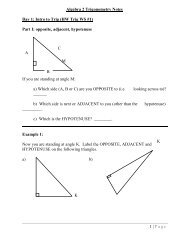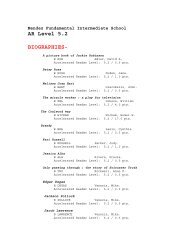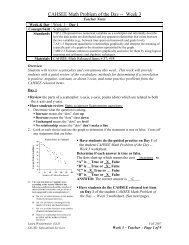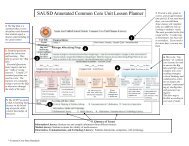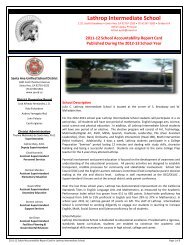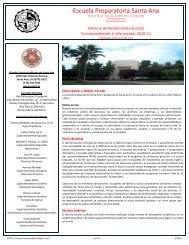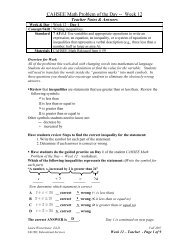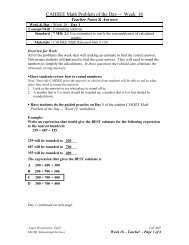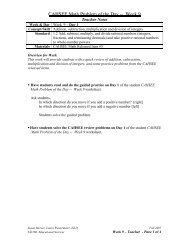You also want an ePaper? Increase the reach of your titles
YUMPU automatically turns print PDFs into web optimized ePapers that Google loves.
Chemical Bonding• Infer the number of valence electrons using the periodic table and then construct its Lewis dot structure.• Describe the formation of a cations and anions and how to use the octet rule.• List the characteristics of an ionic bond.• List the characteristics of covalent bond.• Explain properties of ionic compounds including electrical conductivity using the metallic bondingtheory.• Describe the formation of an ionic bond.• Describe the formation of a covalent bond.• Describe double and triple bonds.• Create electron dot diagrams for covalent molecules containing single, double, and triple bonds.• *Describe the shapes of simple covalently bonded molecules using VSEPR Theory.• *Using electronegativities, categorize a bond as nonpolar covalent, polar covalent, or ionic.• Show the relationship between polar covalent bonds and polar molecules.Nomenclature (Writing and Naming Chemical Formulas)• Locate these items on the periodic table: group, period, representative element, transition element.• Define the terms cation and anion and show how they are related to the terms metal and nonmetal.• Distinguish between ionic compounds and molecular compounds.• Distinguish among chemical formula, molecular formula, and formula unit.• Infer the charge of an ion using the periodic table.• Define a polyatomic ion and recognize the names and formulas of common polyatomic ions.• Write the chemical formulas for binary ionic compounds.• Identify a binary ionic compound by name when given the formula of the compound.• Identify by name and write formulas of binary molecular compounds.Moles and Stoichiometry• Know the definition of a mole• Describe how Avogadro's number is related to a mole of any substance.• Distinguish between the terms gram atomic mass, gram molecular mass, and gram formula mass• Calculate the mass of a mole of any substance and convert between moles and mass of a substance.• Convert moles to volume and volume to moles, using the volume of one mole of a gas at STP (22.4 L).• Convert among measurements of mass, volume, and number of particles, using the mole.• *Calculate and determine the limiting reactant• *Calculate the percent composition of a substance from its chemical formula or experimental data.Gas and Their Properties• Know the Kinetic Molecular Theory and how it explain behaviors of gases• Know how to convert between temperatures and between pressures• Know the value and meaning of STP• Know the relationships between pressure, volume, and temperature of a gas using the Gas Laws(Boyle’s, Charles’s, Gay-Lussac’s, Combined)• Know how to solve problems using the ideal gas laws*-Honors Topics only2008



